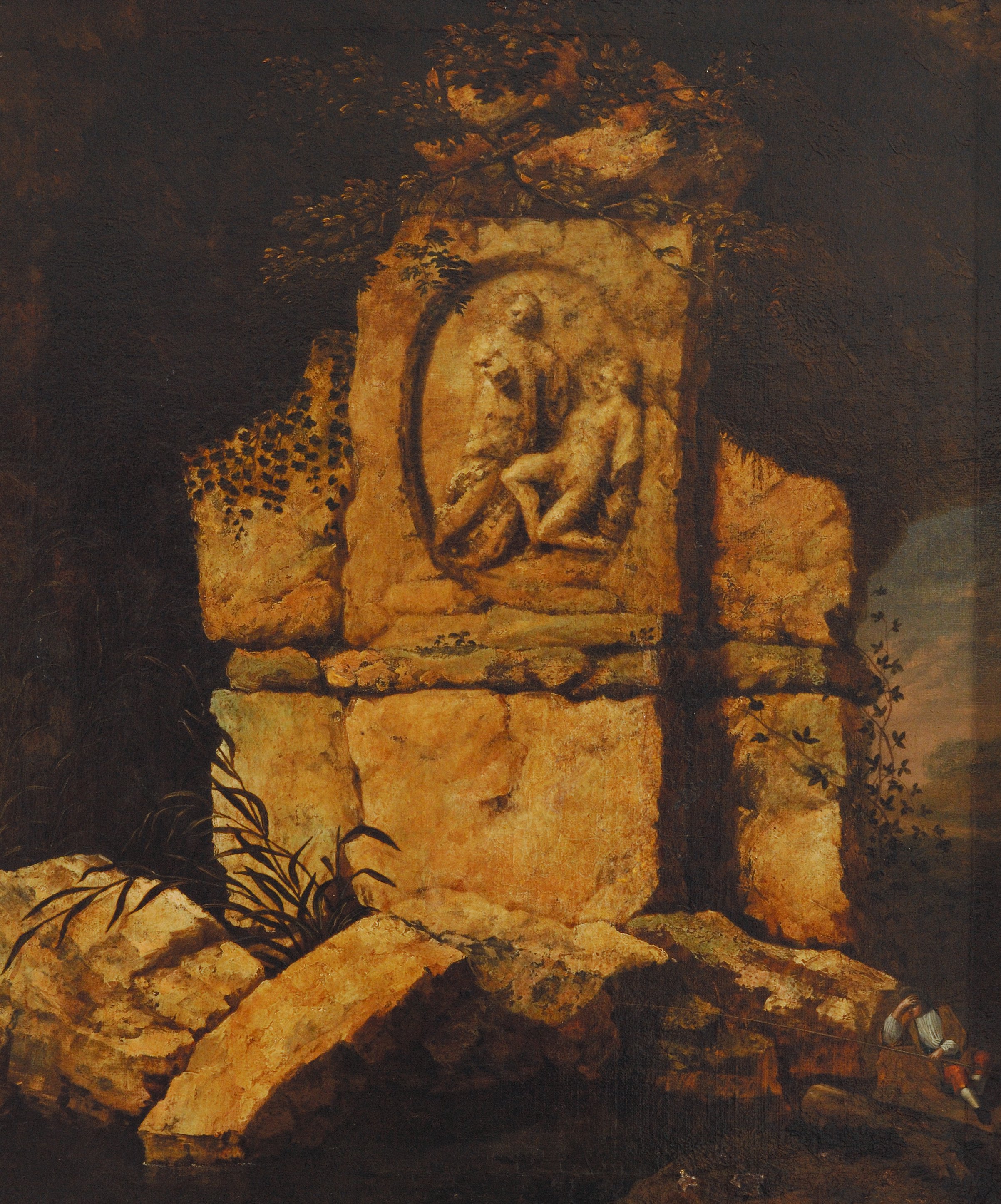20. Ruined Tomb, by Wilhelm Schubert von Ehrenberg
 Ruined Tomb, Wilhelm Schubert von Ehrenberg, H 67.3 x W 55.9 cm, oil on canvas
Ruined Tomb, Wilhelm Schubert von Ehrenberg, H 67.3 x W 55.9 cm, oil on canvas
There is something decidedly
‘Romantic’ about the character of this painting. The depiction of an ancient,
crumbling tomb, entwined with ivy - its stability threatened by the
encroachment of foliage - might elicit from the viewer reflections on
transience, death, and decay. The
contrast between the memorial’s luminosity and the dark, mysterious recesses of
the grotto that encloses it lend the scene a striking melodrama. Yet the
painting, completed in the latter half of the 17th century,
prefigures the Romantic period by well over a century. Its creator, the
Dutchman Wilhelm Schubert von Ehrenberg, was known primarily as an
architectural painter, and seems to have been most interested in rendering in
detail large interior scenes, both real and imaginary. The diaphanously
illuminated, colossal built environment of Interior of a Church
(Kunsthistorisches Museum, Vienna) reveals the
artist’s savouring of intricate Baroque architectural detail. Although far more
modest in scope, Ruined Tomb demonstrates a comparable sensitivity to
the theatrical play of light and treatment of staffage (human or animal figures
within scenes, which were added for visual interest and as indications of scale).
The warm glow of the stone is
facilitated by a light source emanating from the left of the scene - perhaps
the setting sun. This glow not only lifts the tomb from the shadows of its
stony environs, but also puts into relief the two figures engraved in its
central oval. Who are these figures? We will never know. Even their gender is
difficult to establish, although the flowing garments on the erect figure
suggest a feminine identity. Perhaps she is administering help to an afflicted
loved one, whose swooning posture portentously foreshadows his (or her) demise.
What we do know is that throughout the
course of the 17th century a number of Dutch painters – including
Charles and David de Hooch, Abraham van Cuylenborch and Rombout van Troyen – travelled
to Italy to take artistic inspiration from the country’s grottos and caverns,
many of which contained ancient Roman ruins and tombs carved with mythological
subjects. Van Cuylenborch’s Landscape
with Ancient Ruins (Städel Museum, Frankfurt)
is a fine example. Even if Von
Ehrenberg did not travel to Italy himself, he may have been inspired by these
scenes, flooded with warm Southern evening light, of vanity and decay.
But these two engraved bodies are
not the only figures in the scene. To the lower right-hand side we can make out
a man, dressed in contemporaneous garb, who, on initial inspection, appears to be
reclining respectfully at the foot of the tomb. A closer look reveals a fishing
rod in his right hand; his left hand shields his tired eyes from the sun, and
his whole demeanour indicates workaday weariness. He seems oblivious to the
imposing classical structure that rises magnificently behind him, being intent
solely on what he can find in the waters that flow beneath the bridge-like
structure on which the monument sits. We have a curious coinciding of the
classical and contemporary, the Arcadian and the quotidian. This humble
character seems to have been transported from a more traditional Dutch Golden
Age landscape painting, in which incidents of everyday life punctuated and animated
panoramas of fields and sky.
Of course, the fisherman is also a
useful indicator of scale, revealing to the viewer that this tomb was almost as
vast as some of the buildings that von Ehrenberg delighted in painting. Its shape,
reminiscent of a church façade (with its central part representing the nave and
its two stone ‘wings’ the aisles), emphasises its architectonic nature.
Ruined Tomb has a smaller companion
piece on the same theme (confusingly it shares the same name), which also
belongs to the College. Both works were given to St John’s by Mrs Anne Derham,
the mother of William
Derham, who was President of the
College from 1748-57. Other gifts from Anne Derham include Landscape with
Tree and River Scene by Anthonie Jansz van der Croos, which Dr
Jennifer Johnson has discussed in an earlier
blog post. Ruined Tomb underwent substantial restorative treatment
in 1986, involving the delicate removal of large areas of repainting which had
been added in a slightly lighter colour than the original paint - thereby
giving the original a somewhat misleading ‘misty’ look. What we see now is a
canvas restored as closely as possible to its original appearance.
View the painting
on Art UK here.
 Rachel Coombes is a third-year Art History DPhil student at St John's, where she is writing a thesis on the post-Impressionist French painter Maurice Denis, under the supervision of Professor Alastair Wright. Her broad research interests lie in the interrelationship between music and the visual arts in 19th- and 20th-century France.
Rachel Coombes is a third-year Art History DPhil student at St John's, where she is writing a thesis on the post-Impressionist French painter Maurice Denis, under the supervision of Professor Alastair Wright. Her broad research interests lie in the interrelationship between music and the visual arts in 19th- and 20th-century France.